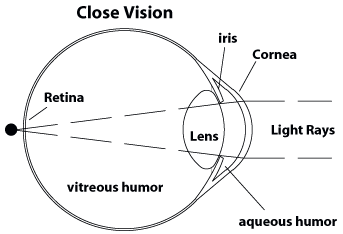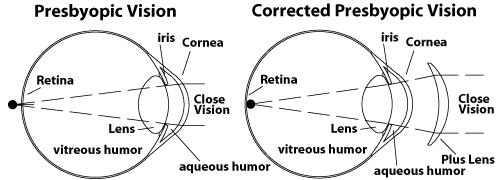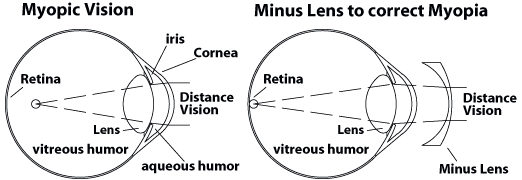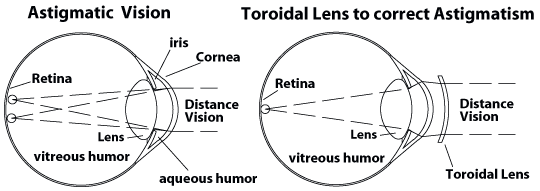
|
|
|
||||
|
|
|
|
Your
Vision |
|
Note: The
information provided here is not a substitute for professional care.
If you are having any problems with your eyes, you should see your
ophthalmologist or optometrist for diagnosis and treatment. The Eye is a magnificent piece of engineering: it takes external light rays through the lens system and focuses them on the Retina, where the optical nerve connects to the brain where the vision is processed. A simplified Eye Cross Section Figure
1 The main parts of the eye lens system are the Cornea and the Lens. The cornea, optically, is a fixed PLANO POWER bent lens. The Lens itself, optically, is a variable radii BI-CONVEX flat lens. For distance vision, the eye is in a fixed focus mode: the Lens is at a rest position, that is, is in a fixed position with maximum radii. The light rays coming through the cornea, are bent toward the Lens, where they are bent (or refracted) again toward the back of the eye and focused on the Retina For close vision, the eye is in an auto focus mode. The change in the Lens radii is called Accommodation. If the Lens would not accommodate, the light rays would be focused behind the retina and the vision would be blurred, as shown in below. Figure 2
When the Lens accommodates, that is, it changes its spherical radii, the focal point moves to the correct point on the retina. Muscles in the Lens change its shape, making it of stronger power by decreasing the radii of both curvatures. The figure below shows the accommodated Lens for close vision. Notice the difference in the Lens shape before and after accommodation. Figure
3
As we get older, the Lens of the eye loses its flexibility and the muscles that control its shape become weaker: the eye auto-focus system for close distance vision is degraded. Objects seen at short distance focus behind the retina, causing blurred vision. Figure 2 above shows this condition. This condition is called
PRESBYOPIA (Greek for old eyes), and refers to the eye's loss of
ability to focus on close objects by changing the Lens shape.
Presbyopia may seem to occur suddenly, but it actually progresses gradually from a young age and it begins to be noticeable when one reaches their forties. Unfortunately, it does not stop at the forties, it keeps on progressing. To correct this condition, your optometrist or ophthalmologist can prescribe reading glasses, bifocals, trifocals or contact lenses. Since presbyopia may be more advanced in one eye than the other, the reading glasses may have lenses of different power. Reading Glasses are simple "Plus Lenses", which move the focal point of light from the back of the retina forward directly to the retina. Mild presbyopia is corrected with low power lenses (1.0 or 1.5 diopter). Stronger presbyopia needs higher power lenses, 3.0 or higher. Since presbyopia progresses with time, stronger lenses are required as we age. At 45 we may need 1.5 diopter lenses, but at 60, we will need stronger lenses. If your eye doctor determines that your presbyopia is the same for both eyes and you do not have any other vision problems, he/she may suggest that off the shelf reading glasses may be OK for you. Figure 4
Notice that in the above figure, the Lens has not changed its shape (radii). Your eyes are precious. Periodic check-ups with an optometrist or ophthalmologist will ensure your vision health. Below there is information about other eye problems.
Myopia or Nearsightedness, unlike Farsightedness, moves the focal point of light in front of the retina instead of directly on it. Like Hyperopia, this is not an age-induced condition, but it is also caused by an abnormality on the eye shape (cornea, lens or eyeball). People with this condition may have good close vision, but have difficulty for distance vision. This condition may be corrected with Minus Lenses: surgery and other procedures are available for adults who desire to see without glasses. Consult with your eye doctor on how to best treat this condition. Figure 5
Astigmatism is a condition that causes light to focus on more than one point on the retina, resulting in blurred, close and distance vision and often occurs along with Hyperopia or Myopia. This is not an age-induced condition, but it is also caused by an abnormality on the eye shape (cornea, lens or eyeball): a normal eye Lens-System is spherical, but an Astigmatic one is not, having a more elliptical shape. You may remember from your high school geometry that an ellipsis has two focal points: the light rays entering the eye are focused in more than one point on the retina causing the blurred vision. This condition may be corrected with Toroidal lenses or surgery. Consult with your eye doctor on how to best treat this condition. Figure
6
Since Astigmatism often occurs along with Hyperopia or Myopia, the lenses to correct the vision may be a combination of Toroidal, Minus or Plus lenses.
Surgical Procedures for vision correction. As we discussed before, the mayor vision problem can be corrected with optical lenses. In the XX century, great advances have been made in surgery for vision correction. The following is a brief informational non-technical description of some of the procedures. Although there are other surgical procedures, here we describe some of them. For more details, consult with your eye doctor. RK (Radial Keratotomy). Astigmatic Keratotomy
(AK) Laser Surgery
LASIK (laser in-situ
keratomileusis). IntraLASIK (all-laser
LASIK).
And
don't forget, periodic check-ups with an eye doctor will ensure
your vision health.
|
|
|
|
|





